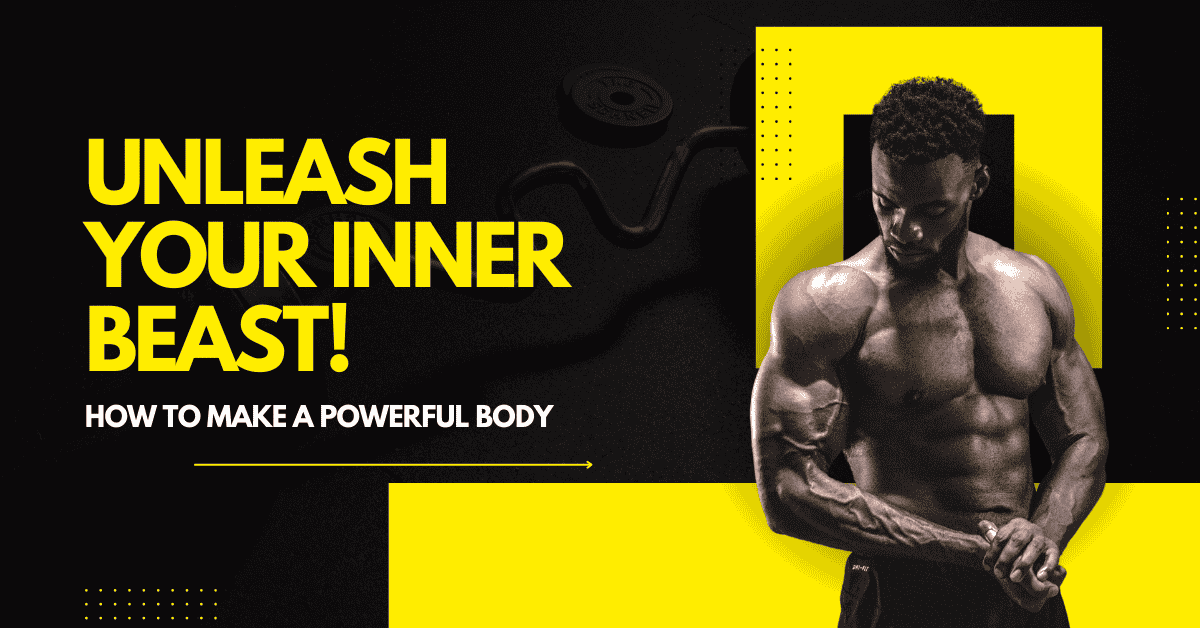A strong body is not just about a strong frame, it’s a sign of discipline, strength, resistance, and health. Powerlifting, bodybuilding and weight lifting mean pushing your limits — your physical, mental and nervous system limits — in the gym, week after week, month after month, year after year to achieve strength, performance, physique or overall power and function.
We’re here to help you in your quest with everything you need to know to build a powerful body—broken down into easy-to-understand steps proven by sound science—and usable for beginners and meatheads.
1. Define Your Personal Interpretation of Powerful
Set your goal before you start lifting weights or counting calories.
- Would you like to appear strong like a bodybuilder?
- Do you wanna be explosively strong, like a sprinter or powerlifter?
- How about general performance and stamina?
Knowing your brand of “powerful” can help you arrange your workouts, diet and life in general, for that matter.
2. Get a good foundation with Strength Training
Strength training is the base of creating a strong body. It gets you more muscle, more bone, and more elastic, and makes your body better able to execute.
Focus on Compound Movements
These are compound movements that engage more than one less at a time:
- Squats – Quads, bum and core at work.
- Deadlifts – Work the back, hamstrings and grip.
- Bench Press – Chest, Shoulders, Triceps The Exercise
- Pull-Up/Chin-Up – Works back, biceps, and grip strength.
- Overhead Press – Builds power in the shoulders and upper chest.
Progressive Overload
This can be progressively adding weight, reps or intensity to push your muscles. It is the essential principle for muscle growth and strength.
3. Train With a Program
Don’t go to the gym and “wing it.” Or try something like this structured program:
- Push-Pull-Legs (PPL) split
- Upper-Lower split
- Body: Full body (3 times per week)
Stick to one program for 8–12 weeks and track your progress.
4. Nourish Your Body: The Power of Nutrition for Strength
You can’t expect to have a powerful body if it isn’t properly fueled. Think of food as fuel — and as forming the building blocks of your muscles.
Prioritize Protein
Muscles are built of protein, and without enough protein, your body will not grow.
- Aim to get 1.6–2.2 grams of protein per kg of body maintenance.
- Good sources: chicken, fish, eggs, lentils, tofu, whey protein, Greek yogurt.
Eat Enough Calories
If you’re not getting enough to eat, your body won’t have enough energy to grow.
- Surplus for lean muscle growth: slightly over maintenance.
- Deficit for fat loss (if necessary): A touch under maintenance and keep protein high.
Don’t Neglect Carbs and Fats
- Carbs fuel your workouts. Add oats, rice, sweet potatoes, fruits.
- Fats are necessary for hormone synthesis. Add nuts, seeds, avocado, olive oil.
5. Focus on Recovery and Sleep
Training breaks muscles down; recovery builds them up.
Sleep Is Crucial
- Shoot for 7–9 hours of high-quality sleep.
- Sleep increases testosterone, growth hormone and muscle repair.
Rest Days
Allow yourself 1–2 days of rest each week. Excessive training causes fatigue and injuries.
Active Recovery
Walk, do yoga or light cardio on rest days to promote blood flow and reduce soreness.
6. Cardio for a Balanced Body
Cardiovascular enhances heart health and is great for endurance; it also helps recovery.
Add Low-Intensity Steady-State (LISS).
Fast walking, cycling or swimming for 30–45 minutes, at least 2–3 times a week.
What is High Intensity Interval Training (HIIT)?
Brief, intense bursts of effort separated by periods of rest. Good for losing fat and building stamina.
For muscle gain, don’t overdo it with cardio — it’s all about balance.
7. Be patient and keep a log of your progress.
You don’t build an impressive looking body in a week, or a month or even a year. The secret? Consistency.
Track:
- Your training (pounds, reps, sets)
- Your body (bodyweight, measurements, progress pics)
- Your diet (at least in the first couple of weeks)
They can use apps like MyFitnessPal or Strong, or simply keep a record in a notebook.
8. Emotional Toughness and Discipline
Strong body is also a strong mind.
- Establish realistic, small objectives and reward yourself for checking them off.
- Keep motivated by reading books, following fitness influencers or joining a gym community.
- Don’t avoid a workout because you’re tired or feeling too busy. Just show up.
- Get past plateaus — they’re part of the process.
Strength building is mental as well as physical.
9. Supplements: Do We Need Them?
Supplements can make a difference, but they aren’t magic.
Useful ones:
- Whey Protein – Convenient and quickly absorbed source of protein.
- Creatine Monohydrate – 2g a well studied supplement for both strength and muscle.
- Fish Oil – Helps decrease inflammation and maintain joint health.
- Multivitamins – For filling in gaps in the diet.
Optional:
- Pre-workouts for energy, BCAAs (and really the only helpful use is if you’re training fasted), mass gainers (if and only if you’re having trouble getting enough calories).
Supplements are just a small piece of the puzzle — concern yourself with food first.
10. Avoid Common Mistakes
Here’s what to watch out for:
- Overtraining without adequate rest
- Under eating or constantly eating junk
- Emphasizing looks over performance
- Mimicking influencers with no strategy
- Giving up too soon
Sample Weekly Routine for Beginners
| Day | Workout |
| Monday | Push (Chest, Shoulders, Triceps) |
| Tuesday | Pull (Back, Biceps) |
| Wednesday | Rest or Light Cardio |
| Thursday | Legs + Core |
| Friday | Upper Body (Full) |
| Saturday | Active Recovery or Cardio |
| Sunday | Rest |
Adjust the plan as per your recovery and goal.
11. Bonus Tips For Keeping It Off In the Long Run
- Keep educating yourself – fitness changes. Read, watch, listen.
- Train on Purpose – Take your Sets, don’t take them in a hurry.
- Forget weight and lift for form.
- Switch it up every few months – the number of sets, the repetitions, or the exercises.
- Get a coach or workout
Conclusion
Building a strong body is not necessarily just a matter of lifting weights or eating chicken and rice. It is, in fact, an integrated lifestyle that turns on training smart, eating properly, recovering well and mentally applying oneself. Anyone can have a strong, powerful body once they apply the right approach and stick with it.
Begin where you are, use what you have, and do what you can. Your best body is created rep by rep, meal by meal, day by day.


